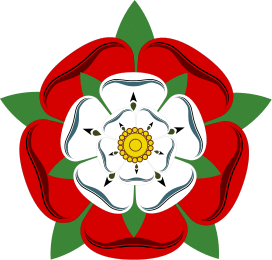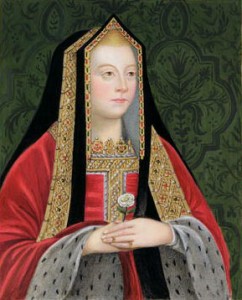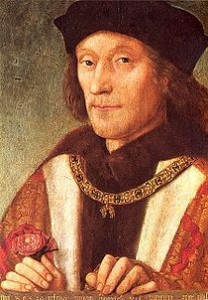 On this day in history, 18th January 1486, King Henry VII married Elizabeth of York. The bridegroom was 29 years old and the bride was nearly 20 and they were, as David Starkey describes them, “a striking couple”1.
On this day in history, 18th January 1486, King Henry VII married Elizabeth of York. The bridegroom was 29 years old and the bride was nearly 20 and they were, as David Starkey describes them, “a striking couple”1.
Elizabeth of York “was one of the beauties of her age” with her classic English Rose looks – blonde hair, blue eyes and fair skin – and she was also “singularly attractive as a character too”, in that “she was a healer and reconciler”2. Her husband was tall, slim, dark haired, handsome and “in the prime of his life”, and he also had many good qualities: courage, decisiveness and “the ability to master men and events”3. They were, in short, the perfect couple and the perfect King and Queen, plus their marriage reconciled the warring Houses of Lancaster and York and their reign started a new royal house and era: The Tudor dynasty.
The Bride
You can find out more information about Elizabeth of York at “Happy Birthday and RIP Elizabeth of York”, but here is some background on Henry VIII’s beloved mother.
 Elizabeth of York was born on the 11th February 1466 and was the daughter, and eldest child, of Edward IV and Elizabeth Woodville. Her father had managed to capture and imprison Henry VI in 1461, dethroning him and taking the crown for himself, starting the royal House of York. In 1464, he secretly married Elizabeth Woodville, a young widow. It was a love match, not a diplomatic one, and, as David Starkey points out, was controversial and caused trouble when Elizabeth alienated powerful Yorkist supporters, causing them to side with Lancastrians and challenge Edward. The result was that Edward was driven into exile and the throne became Henry VI’s once more in October 1470. Henry’s reign was shortlived as Edward overthrew him once again in April 1471. David Starkey writes of how, this time, Edward decided that “there would be no survivors”4 – ex Yorkists and Lancastrians were defeated in battle and Henry VI was killed in the Tower. Edward had stamped out his enemies.
Elizabeth of York was born on the 11th February 1466 and was the daughter, and eldest child, of Edward IV and Elizabeth Woodville. Her father had managed to capture and imprison Henry VI in 1461, dethroning him and taking the crown for himself, starting the royal House of York. In 1464, he secretly married Elizabeth Woodville, a young widow. It was a love match, not a diplomatic one, and, as David Starkey points out, was controversial and caused trouble when Elizabeth alienated powerful Yorkist supporters, causing them to side with Lancastrians and challenge Edward. The result was that Edward was driven into exile and the throne became Henry VI’s once more in October 1470. Henry’s reign was shortlived as Edward overthrew him once again in April 1471. David Starkey writes of how, this time, Edward decided that “there would be no survivors”4 – ex Yorkists and Lancastrians were defeated in battle and Henry VI was killed in the Tower. Edward had stamped out his enemies.
Unfortunately, tragedy struck the House of York at Easter 1483 when Edward caught a chill on a fishing trip. He died on the 9th April and his 13 year old son, Edward, became Edward V. Edward V was too young to reign in his own right so his uncle, Richard, Duke of Gloucester, became the Protector. However, to cut a rather long story short, this was not enough for Richard. With Edward and his younger brother, Richard, Duke of York, ‘residing’ in the Tower of London, Richard was crowned King Richard III on the 6th July 1483 and the boys disappeared, going down in history as ‘The Princes in the Tower’.
Elizabeth of York mourned the loss of her brothers but her mother decided on revenge and this is when she decided to approach Lady Margaret Beaufort. Although the two ladies were supposed to be on different sides, Elizabeth being from the House of York and Margaret being a Lancastrian, neither lady was happy with Richard on the throne and decided that a union between their children could bring about Richard’s downfall. The rest, as they say, is history.
Trivia: It is said that it is Elizabeth of York who is the Queen of Hearts on playing cards.
The Bridegroom
 Henry VII was born at Pembroke Castle on the 28th January 1457. His parents were the 13 year old Lady Margaret Beaufort and his father was Edmund Tudor, 1st Earl of Richmond, who, unfortunately, had died of the plague three months before Henry’s birth.
Henry VII was born at Pembroke Castle on the 28th January 1457. His parents were the 13 year old Lady Margaret Beaufort and his father was Edmund Tudor, 1st Earl of Richmond, who, unfortunately, had died of the plague three months before Henry’s birth.
David Starkey writes of how both Margaret and Edmund came from “satellite families”5 to the House of Lancaster. Edmund Tudor was the son of Owen Tudor and Catherine Valois (Catherine of France), the widow of Henry V and mother of Henry VI, and Margaret Beaufort was descended from John of Gaunt, Duke of Lancaster and third son of King Edward III, and his mistress, and eventual wife, Katherine Swynford. Neither of Henry’s parents had a strong claim to the throne, with Edmund having no English royal blood and Margaret being descended from a line which was deliberately excluded from the succession, but this did not stop Henry VII from claiming the throne after his Lancastrian forces defeated Richard III’s Yorkist forces at the Battle of Bosworth Field on the 22nd August 1485 and Richard was killed.
You can read more about the Battle of Bosworth Field, the Wars of the Roses and the Houses of Lancaster and York in the following articles:-
- The Battle of Bosworth 1485 Part 1 – The Wars of the Roses
- The Battle of Bosworth 1485 Part 2 – The Battle
On the 27th August 1485, Henry entered London as King Henry VII and he was crowned on the 30th October. On the 10th December, Parliament petitioned him to marry Elizabeth of York, the Speaker declaring “Which marriage, they hoped God would bless with a progeny of the race of kings, to the great satisfaction of the whole realm”6. Henry agreed and the marriage took place five weeks later. It had been planned for some time and their betrothal, which had been cooked up by Elizabeth Woodville, Elizabeth of York’s mother and Edward IV’s widow (and mother of the missing princes in the Tower) and Margaret Beaufort, saw the union of the Houses of York and Lancaster which led to the “joint rising” against the usurper, Richard III, and “a new unified regime in which York and Lancaster would sink their ancient differences.”7
The marriage between Henry and Elizabeth was happy and successful. The couple had four children who survived childhood: Arthur, Henry (Henry VIII), Margaret and Mary, but Elizabeth died on her birthday in 1503 at the age of 37. She died from a post-partum infection and her husband was said to have been devastated, as was her 11 year old son, Henry, who adored his mother. He had been close to his mother and, as second son, it was Elizabeth who had taught him to read and who had been responsible for his upbringing. I often wonder if Henry was expecting his wives to measure up to the image he had of his mother, the perfect wife and queen.
I’ll leave you with a poem that Elizabeth of York is said to have written:-
“MY heart is set upon a lusty pin ;
I pray to Venus of good continuance,
For I rejoice the case that I am in,
Deliver’d from sorrow, annex’d to pleasance,
Of all comfort having abundance ;
This joy and I, I trust, shall never twin
My heart is set upon a lusty pin.I pray to Venus of good continuance
Since she hath set me in the way of ease ;
My hearty service with my attendance
So to continue it ever I may please ;
Thus voiding from all pensful disease,
Now stand I whole far from all grievance-
I pray to Venus of good continuance.”8
Notes and Sources
- Henry: Virtuous Prince, David Starkey, p18
- Ibid.
- Ibid.
- Starkey, p27-28
- Ibid., p19
- Ibid., p38
- Ibid.
- Poets royal of England and Scotland, edited by William Bailey-Kempling (1908)